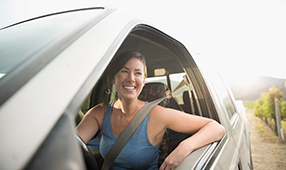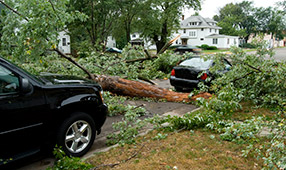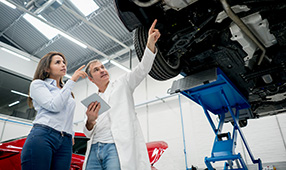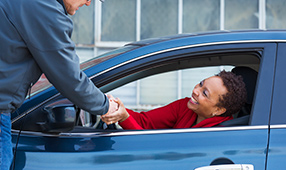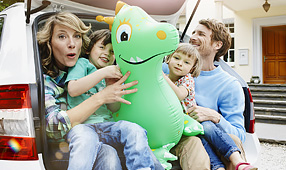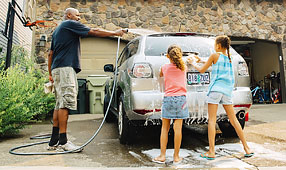Wearing seat belts, observing speed limits and road signs, and knowing your route well are general keys to driving safety. But when the weather changes, being prepared can help you prevent an unscheduled visit to a repair shop.
Whether you’re dealing with a tire blowout on a hot summer afternoon or trying to remedy a dead battery on the first cold day of fall, each season presents its own special challenges for drivers. Staying up to date on your vehicle maintenance, and knowing how to deal with the conditions and hazards you might encounter, can help keep you on a safer, happier road all year long.
Then, do your due diligence by being aware of the common issues you could encounter when you hit the road throughout the year.
Winter driving hazards to watch out for
Snowstorms. If you get stranded on the road in a storm, these actions can save your life:
- Call for emergency help immediately.
- Stay in your vehicle to stay warm and to protect yourself from other vehicles that might slide and hit your car.
- Crack the window slightly and keep snow cleared from the exhaust pipe to prevent carbon monoxide poisoning.
- Run the engine for short periods of time for warmth and to recharge the battery.
Carbon monoxide poisoning. Exhaust leaks or a clogged exhaust pipe can send dangerous fumes into your vehicle. Get your emissions system checked before winter arrives, crack the windows when driving, and never run a car inside a garage or other enclosed space.
Slick roads. Slipping and sliding on ice, snow or rain is a leading cause of winter driving wrecks. When roads are slippery, longer stopping times and increased distance between vehicles are essential. And don’t be lulled into complacency: Although all-wheel and four-wheel drive vehicles can provide better traction, they don’t offer better stopping in winter conditions.
Spring/Summer driving hazards to watch out for
Excessive heat. This is deadly for children and pets. Never leave them unattended in a vehicle, even on mild, sunny days. High temperatures also can drain the battery quickly, so get yours tested to see if it’s in good shape or needs to be replaced.
Increased traffic. When the weather’s nice, more cyclists and pedestrians take to the roads, which requires vehicle drivers to be more alert of their surroundings. If you’re hitting the road on a motorcycle, wear safety equipment (helmet and thick or padded pants, jacket and gloves) and take a test ride to make sure everything is working properly and to get a feel for the road. Use headlights and bright colors to help drivers see you better. May is Motorcycle Awareness Month, which aims to reduce the number of crashes as warm weather beckons.
Potholes. These spring up en masse in spring, resulting in damage to cars and trucks. Reducing your speed and paying close attention to the road ahead can help you avoid a bone-rattling, costly encounter with a pavement hole that can damage tires, rims and the suspension of your vehicle.
Drowsiness. The switch to Daylight Saving Time on the second Sunday in March (in most areas of the country) can severely affect sleep patterns, especially in people who already are sleep-deprived.
Fall driving hazards to watch out for
Busy school zones. During back-to-school season, it’s imperative to observe school-zone speed limits and be aware of students walking or biking near schools. Remember to stop for all buses when the lights are flashing and the stop arm is out.
Slick roads. Fall can be a slippery time of year, with wet leaves and the first snow or ice of the season impacting driving conditions. It’s time to slow down and adjust for how your vehicle handles the road when it’s not dry.
Wildlife. Fall is prime time for crashes with animals, which spike from October through December. An estimated 1.5 million drivers strike deer each year. In areas where deer or elk roam, slow down, observe warning signs, break firmly, and try to avoid violent swerving if you encounter one in the road. If you hit an animal, attempt to move your vehicle out of traffic, turn on hazard lights, and call law enforcement for help. Don’t approach or attempt to move an injured animal because it may hurt you.
Drowsiness. The return to standard time in early November is another reminder to get enough sleep. Drowsy Driving Prevention Week is dedicated to reducing the growing number of crashes associated with drowsy driving.
Roadside Assistance
Sometimes, despite all of the precautions we take, we need a helping hand when we’re on the road. For extra peace of mind, considering adding roadside assistance to your policy. Roadside assistance often covers:
- Towing
- Lockouts
- Flat-tire repair
- Fuel
- Motor oil
- Dead battery jump
If you get into an accident, make sure you know in advance what to do—and what not to do—to protect yourself. One final step is to get a quote from the NEA Auto & Home Insurance Program and see if it will fit your needs.

